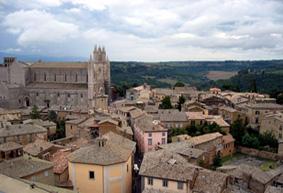


All the structures

Viterbo, bordering Tuscany, Umbria, Rieti in Lazio, the province of Rome and the Tyrrhenian Sea, has great places of interest to visit.
Viterbo’s most prosperous historical period was the 12th century when it was continually fought over by the papacy and empire and began to host popes and conclaves. In this period construction grew, leaving us historic buildings such as the Palace of the Popes, or the 13th century district of San Pellegrino, characterized by towers and dark houses.
Viterbo is famous for its monsters: in 1552 Vicino Orsini withdrew to Bomarzo, where he had fantastic and exotic animals sculpted on the terraces of the park. The Bomarzo monsters perhaps represent the devil’s creatures, the unknown, or ancient cultures.
Among the most important centres in the Viterbo province are Civita Castellana, Tarquinia, Soriano nel Cimino, Oriolo Romano and Montefiascone.
Tarquinia will charm visitors with its 11th century town hall, the Palazzo dei Priori with its four medieval towers and the 16th century Palazzo Sacchetti that incorporates a low, pre-existing tower.
The National Tarquinia Museum offers splendid evidence of the Etruscan civilization in a beautiful, 15th century Gothic and Renaissance palace. Sarcophagi and funeral stones can be seen in the courtyard while the first floor of the building houses the Winged Horses, bronzes, gold work and ceramics.
Viterbo is a province of lakes. First among them is Lake Bolsena, Europe’s largest lake of volcanic origin.
The area of Lake Bolsena is also called ‘high Tuscia’, land populated by the Etruscans in the period of their greatest glory. In the 8th century the area became a power base for the Church. In the medieval period castles and fortifications multiplied, while the 16th and 17th centuries saw the beautiful constructions of the Orsini Palace at Bomarzo, the Farnese Palace at Caprarola and Villa Lante at Bagnaia.
The second lake is Lake Vico, framed by the Cimini mountain range, third is Lake Mezzano, and last is the artificial lake of Monterosi.